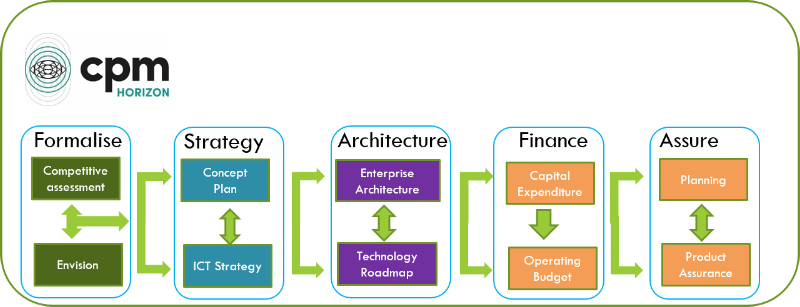All materials on this site are © Computers Processes and Management Ltd. Links | Terms and Conditions Privacy Policy
Computers, Processes and Management (CPM)
Applying People and Technology to Business

CPM Horizon
Sometimes visions and aspirations are not enough, there is a need for a systematic and rigorous review to create pragmatic ROI from those ideas.
CPM Horizon provides a structured method to drive your existing vision, or reimagine your business.

1 Formalise
1.1 Envision:
A vision or idea is often set out as an aspirational and all encompassing paradigm where everyone agrees on the vision. However it is unclear where to start, what is tangible, what is unique, or what can’t be done I.e. when incorporating regulations and limits. A vision can hide this complexity e.g. walk on the moon, single source of the truth, we hold customer details once, and once only, all have hidden complexity.
The objective of the envisioning deliverable is to develop form and structure, incorporate the limits and restrictions around the core vision, helping to tone the vision to the environment. It is often couched in terms of the employee perspective, the customer perspective and or the core of the vision.
1.2 Competitive Assessment:
From envisioning, the current competitive marketplace will be assessed to determine how such a solution would fit within the marketplace. This assessment would include analysis of the products and services currently in the marketplace and where the leadership focus is. The competitive assessment directly supports sales and marketing collateral.
2 Strategy
2.1 Concept Plan
The Concept Plan begins with an idea. But this idea must be capable of being exploited into a full business concept. Identification of that idea should be specified in both a descriptive and restrictive manner to bring focus and structure to developing the solution. Unique features of the idea must be adequately described to identify the inspiration, uniqueness, customer value, employee worth, aspiration, and the motivation to pursue the venture. At the same time, limits must be established and the idea restricted in scope in order to make the effort realistic and commercially viable.
2.2 Information Communications Technology (ICT) Strategy
This will formally set out existing and ICT strategies for the successful development, servicing and operation of the solution. The ICT Strategy will consider the needs for security, support and governance. The principles laid out will set the framework and structure in which the solution will reside. This helps with the decision making process of later components.
3 Architecture
3.1 Enterprise Architecture (EA)
EA defines the characteristics of the solution and will identify the guiding principles of how the solution can be developed, designed and deployed. It will include core features as well as any specific local or industry needs and capabilities. An enterprise architecture considers a number of different domains and integrates these together to define the capabilities of the solution. Typical domains include: applications(A), data(D), technology (T), security(S), process(P), business(B), people(Peo), organisation (O), location(L) and environment(E). Typically BDATS is used for most systems; for specific problems other domains may be used.
The Enterprise Architecture will also consider how the solution integrates into a client environment and the different deployment models required for its implementation e.g. software as a service, proprietary, hybrid, on premise, or a managed service.
The solution will consider operational and production architecture, plus features supporting architecture and governing processes and features, and the target operating model.
3.2 Technology Roadmap:
This will take the solution and specify the technical approach to its delivery. It will break down products, functions and features against a technical delivery timeframe. The Roadmap will also itemise the solution, building blocks, technology infrastructure and the Buy, Build and Adapt components that need to be included to deliver the whole solution. Please note the Technology Roadmap does not take into account the business benefits and value to customers of delivering some components early if these are the ones the market needs.
This Roadmap will support the provision of a high-
4 Finance
4.1 Financial Analysis:
This Stage will develop the CAPEX and OPEX costs for the solution. It will consider build and development through to the operational running and application maintenance of all aspects of the technical solution.
This phase is key as it blends what the market can afford and will pay for (based on the market analysis), with the solution development to help create a product roadmap that can be directed to the territories and industries quickly and effectively.
5 Planning and Assurance
Detailed planning for the delivery of stages of product benefit and tooling for the integration of clients is covered in this Stage. Typically scrum/agile approaches with clearly defined outcomes and deliverables will be undertaken by the delivery teams, with a set amount of freedom of design within a framework approach to delivery. Assurance of delivery, governance, software, software quality and data quality, acceptance criteria and control points for the delivery of the product and the tooling will all be defined, including metrics for successful delivery. Although it is expected that the core team will deliver most of the work, there may be specific quantifiable deliverables where other suppliers and partners can/will deliver. The design and software team will be accountable for the integrated product meeting both functional and non-
| Contact |
| Join us |